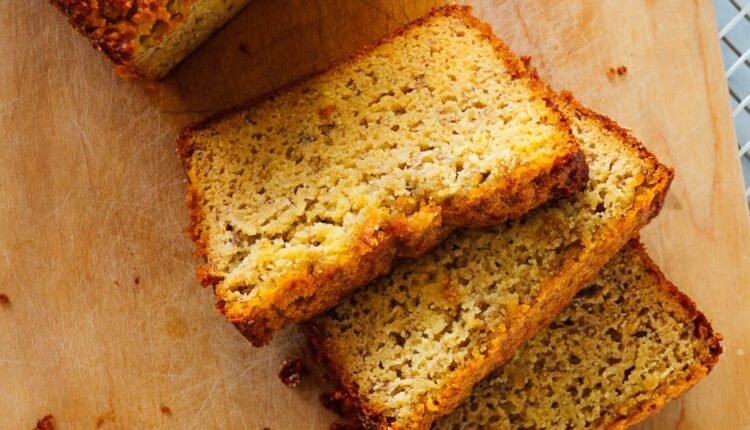Gluten-Free Banana Bread (Made with Almond Flour)

Are we still baking banana bread? Is that still a thing? Of course it is. I developed this gluten-free banana bread recipe in response to one of the most common questions on my healthy banana bread recipe: “Can I make this with almond flour?”
While my go-to banana bread recipe offers other gluten-free options within the post (including a delicious oat flour option), the almond flour answer is not as straightforward. I think it took me seven tries to get this recipe just right!
This version required several modifications, so I’m sharing it as its own recipe today. I’ll also walk you through how I modified the recipe to work with almond flour, which might be helpful if it’s your preferred flour, or you happen to have a surplus in your pantry.
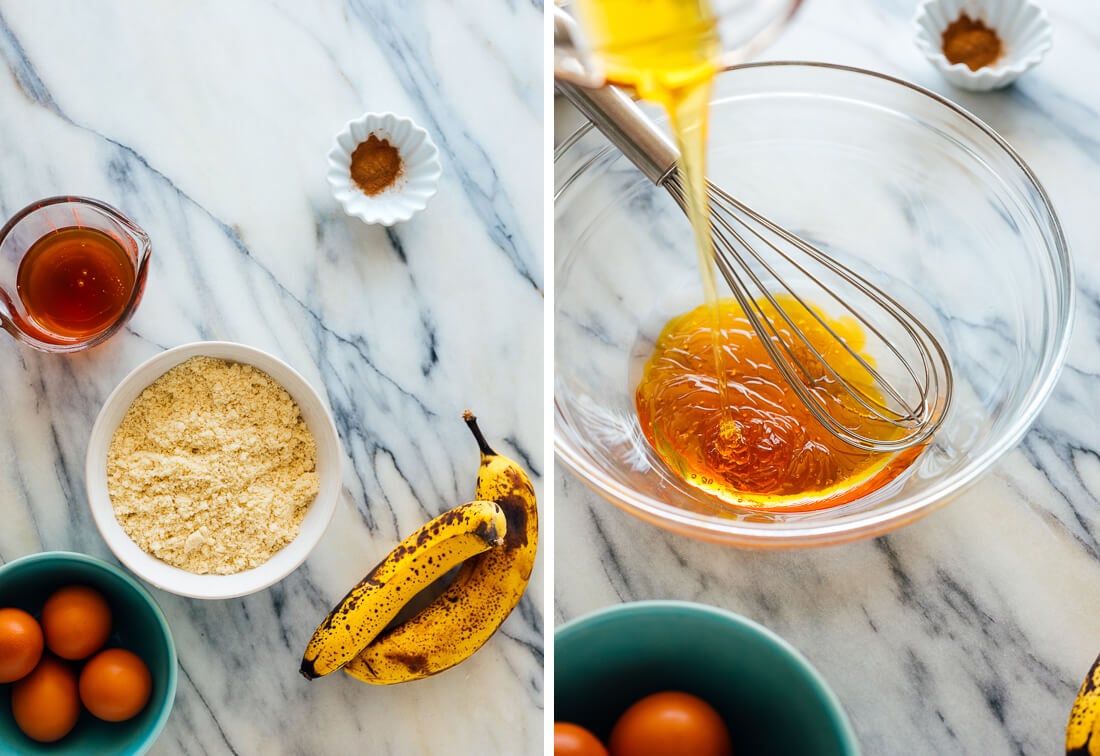
This banana bread is very tender, moist and decadent. These qualities are natural by-products of using almond flour and additional eggs to hold the bread together. This “bread” almost reminds me of pound cake in texture, and it could definitely pass as banana cake—perhaps you’d like to top it with cream cheese frosting.
While it’s different in texture from my favorite banana bread, this gluten-free banana bread is awesome in its own right. Like the other recipe, it’s easy to mix together—by hand, in one bowl, no less! It’s also naturally sweetened with honey or maple syrup. And, I believe it qualifies as paleo as well. Ready to make some?
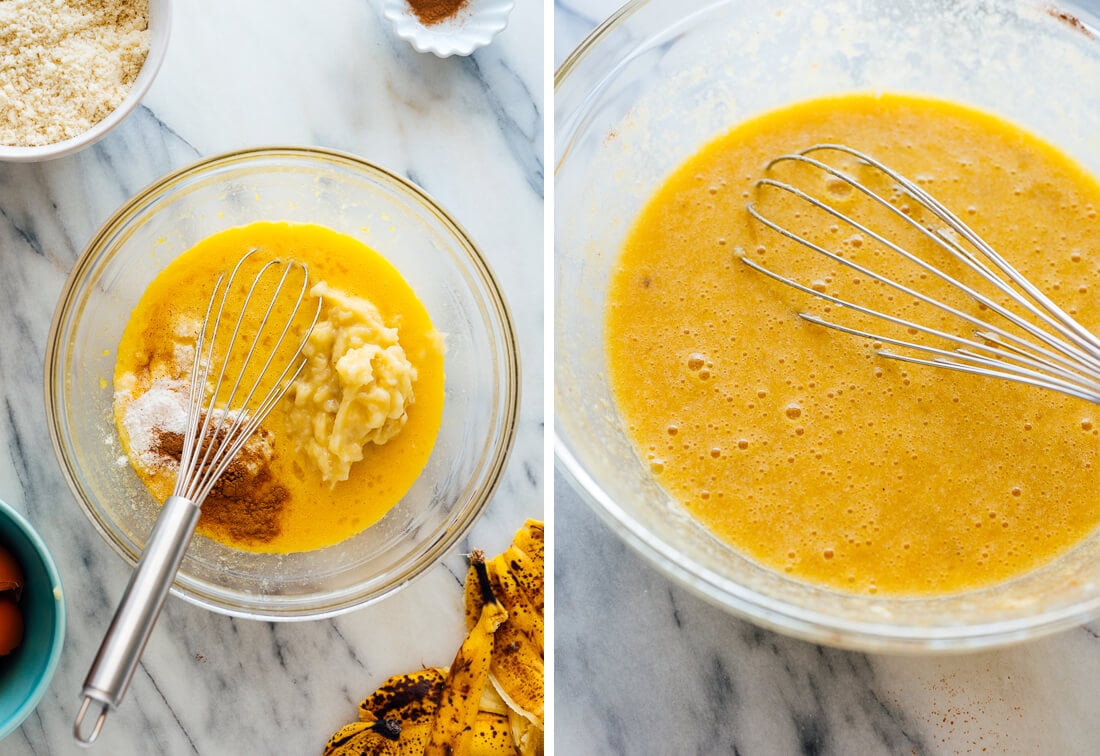
How to Make Almond Flour-Based Banana Bread
I basically crossed my healthy banana bread recipe with the lemony-almond blueberry cake in my cookbook, Love Real Food (page 197). Here are the changes I made, and why:
Substituted the flour by measuring equal weight (in grams), not by volume (in cups).
Almond flour is actually lighter than “regular” flour (all purpose or whole wheat) when you’re measuring them in the same fashion (stirred, spooned into cups, and leveled with a knife). One cup of regular flour weighs about 125 grams, whereas one cup of almond flour weighs about 92 grams. I’ve found that flour substitutions work out better when you keep the weight constant. For example, 1 3/4 cups (220 grams) regular flour is the equivalent of 2 1/2 cups (230 grams, close enough) almond flour.
This is also true for oat flour. Interestingly, with almond flour, I’ve found that another way to keep the weight constant is to simply pack the almond flour into the measuring cups. When fully packed, you can use the original measurement of 1 3/4 cups.
Slightly decreased the oil.
Almonds, like all nuts, naturally contain some oil. They contain more oil than the very small amount you’ll find in whole wheat flour. Fun fact: all-purpose flour has been stripped of all oils, which is why it keeps longer.
I was able to reduce the amount of oil in this recipe slightly, by dropping the oil from 1/3 cup to 1/4 cup. In fact, I was able to get by with as little as 2 tablespoons oil in this recipe, but I love the rich texture produced by 1/4 cup.
Omitted the milk.
Regular flour absorbs far more moisture than almond flour, which is hardly absorptive at all. I found that I didn’t need the small amount of milk (1/4 cup) called for in the original recipe.
Added two extra eggs.
Eggs are absolutely key to achieving a proper rise for baked goods made with almond flour. Most of my baked goods made with regular flour call for two eggs, while this one requires four, or the middle will be deeply sunken in and wet. (In fact, these pictures show the bread slightly sinking in the middle, but my other batches were perfectly mounded—perhaps the eggs used for the photos were smaller than the eggs I had used in previous tests).
Why do you need more eggs? Regular flours contain gluten, which is a protein that provides structure. It essentially creates a framework that fills with air pockets and stays lofty after baking. Almond flour is gluten free, which means that we’re going to have to find structure elsewhere. Real eggs are the only solution that I know of that can provide sufficient structure. Do not try to make this bread with flax eggs instead—you’ll end up with an unappetizing pudding-like situation.
Added baking powder, and decreased the baking soda.
While my banana bread recipe rises beautifully with baking soda, this nut flour-based version needs help from both baking soda and baking powder. Baking powder is double-acting, which means that it starts producing bubbles when mixed with liquid, and produces more bubbles when it’s heated.
Since we added baking powder (which actually contains some baking soda), we’ll decrease the amount of baking soda. Another reason is that baking soda is much stronger than baking powder, and we simply need less when they’re used together.
In summary: The answer to the question, “Can I substitute almond flour?” is not so simple! The good news is that I use a similar formula for many of my quick bread recipes (like my pumpkin bread and zucchini bread) and muffins, so you can likely use this recipe as a template to adjust the others.
Watch How to Make Gluten-Free Banana Bread
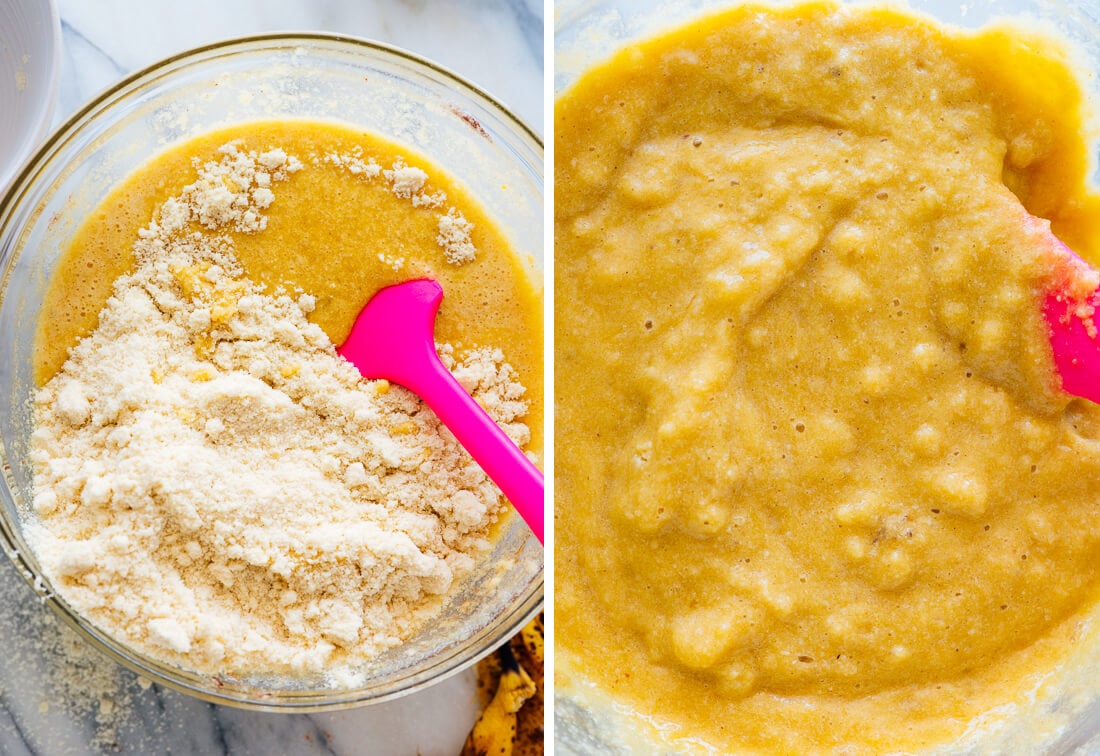
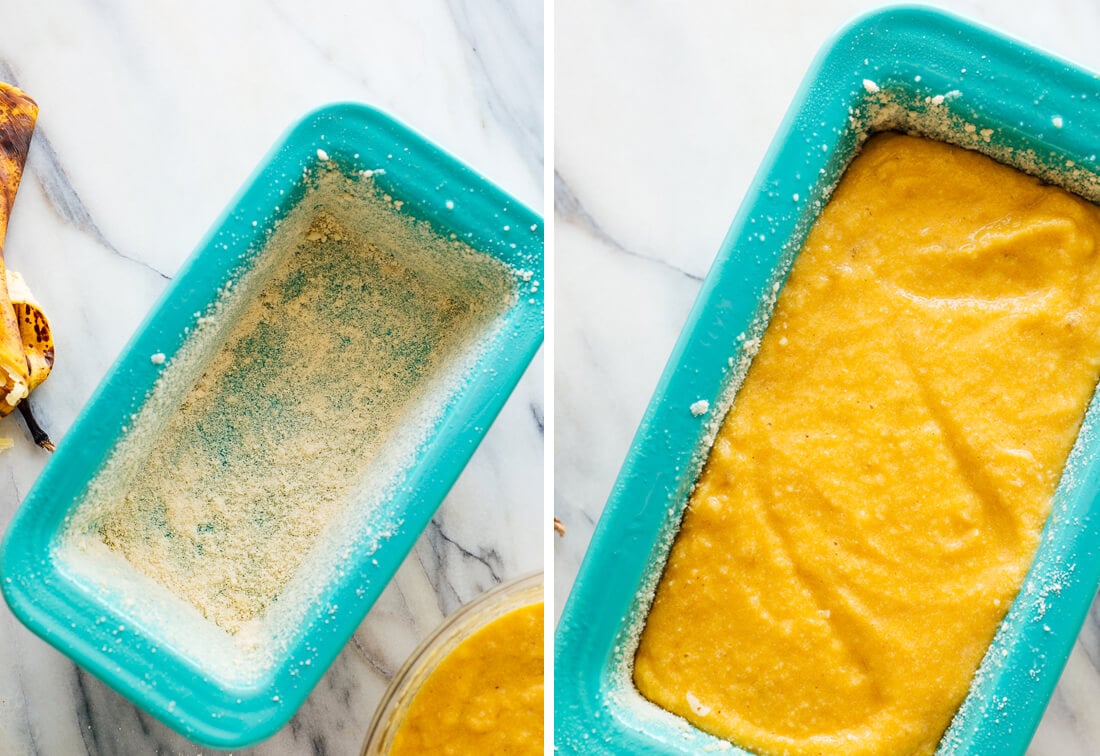
Gluten-Free Banana Bread Recipe Notes
Almond Flour vs. Almond Meal
I’ve used almond meal interchangeably with almond flour in the past, but I strongly recommend using almond flour (made with blanched almonds) in this recipe for the best texture and flavor. I used Bob’s Red Mill’s super-fine almond flour (affiliate link).
How to Measure Almond Flour
Some of my other recipes specify packing the almond flour into the measuring cups, whereas for this one, you’ll measure the flour as you would any other (stir, spoon into cups, and level with a knife). You can read the reasoning behind this at the beginning of the previous section.
Oil & Flour Your Loaf Pan
This is really important! Generously oil and flour your loaf pan as shown in the photo above. If it looks excessive, you’re doing it right. If you don’t sufficiently oil/flour the pan, you might have trouble removing the loaf from the pan after baking.
Let the Bread Cool at Least 30 Minutes
Almond flour baked goods, since they’re gluten free, are especially delicate when they’re warm. You’ll need to let this bread cool in the pan for at least 30 minutes before you try to remove it from the pan or slice it. Trust me!
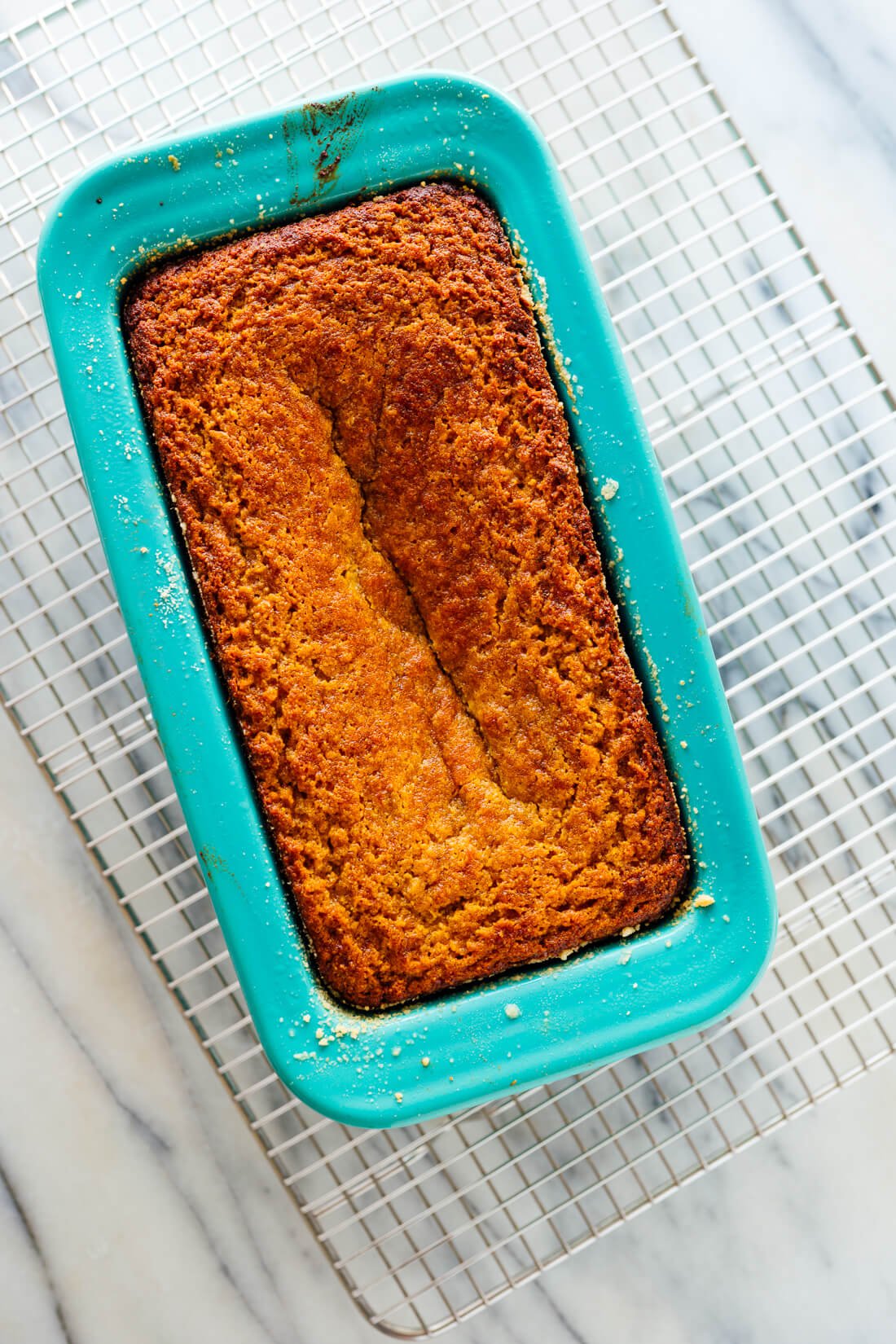
Craving more?
Here are more gluten-free, almond flour-based treats:
- Almond Cake with Berries on Top
- Apple & Carrot “Superhero” Muffins
- Blueberry Almond Crisp
- Peach Crisp
And more banana-flavored treats:
- Banana Cake with Cream Cheese Frosting
- Banana Coconut Muffins or Healthy Banana Muffins
- Banana Nut Scones (vegan)
- Banana Oat Pancakes (gluten free) or Whole Wheat Banana Pancakes
- Banana Oat Waffles (gluten free)

Gluten-Free Banana Bread (Made with Almond Flour)
- Author:
- Prep Time: 20 minutes
- Cook Time: 55 minutes
- Total Time: 1 hour 15 minutes
- Yield: 1 loaf 1x
- Category: Baked good
- Method: Baked
- Cuisine: American
- Diet: Gluten Free
Make this almond flour-based banana bread for a gluten-free treat (it’s paleo, too). Enjoy it for breakfast or a sweet snack. It’s decadent enough to pass as banana cake, especially if you top it with cream cheese frosting. Recipe yields 1 loaf, which is about 10 slices.
Scale
Ingredients
- ¼ cup melted coconut oil or extra-virgin olive oil or high-quality vegetable oil
- ½ cup honey or maple syrup
- 4 large eggs
- 1 cup mashed ripe bananas (about 2 ½ medium or 2 large bananas)
- 1 teaspoon baking powder
- 1 teaspoon vanilla extract
- ½ teaspoon baking soda
- ½ teaspoon ground cinnamon
- ½ teaspoon fine sea salt
- 2 ½ cups almond flour
Instructions
- Preheat the oven to 325 degrees Fahrenheit. Generously grease your loaf pan’s base and sides with cooking oil spray or butter, and generously flour it with almond flour. (Don’t skip this step, or your bread might stick! See photos.)
- In a large mixing bowl, combine the oil and honey. Whisk until blended together. Add the eggs, and whisk until the mixture is thoroughly combined.
- Add the mashed bananas, baking powder, vanilla, baking soda, cinnamon and salt, and whisk to combine.
- Finally, add the almond flour. Switch to a large spoon or spatula, and stir until the flour is fully incorporated into the batter. Pour the batter into your prepared loaf pan.
- Bake for 55 to 65 minutes, until the center of the loaf is fairly springy to the touch and a toothpick comes out clean. Place the pan on a cooling rack to cool for at least 30 minutes (this bread is delicate while warm). Use a butter knife to loosen the edges of the bread from the pan, then carefully tip it over to release. Slice and serve!
Notes
Recipe adapted from my healthy banana bread (which also offers gluten-free options for oat flour and gluten-free all-purpose flour), and the lemony-almond blueberry cake in my cookbook, Love Real Food (page 197).
Change it up: If you want to make this bread extra fruity, you could add up to 1 cup blueberries (lightly floured in almond flour so they don’t sink). Your bread may need up to 1 hour 10 minutes in the oven with this addition. Or, I suspect you could add ½ cup mix-ins like chopped walnuts, pecans or chocolate chips without needing to adjust the baking time.
Storage suggestions: This bread is quite moist and will keep at room temperature for a couple of days, in the refrigerator for up to 5 days, or freeze it for up to several months (slice it first if you’d like to be able to grab a single serving).
Egg free/vegan note: I always try to offer substitution options when possible, but this recipe is highly dependent upon real eggs for structure and lift. I do not know of a workable alternative.
